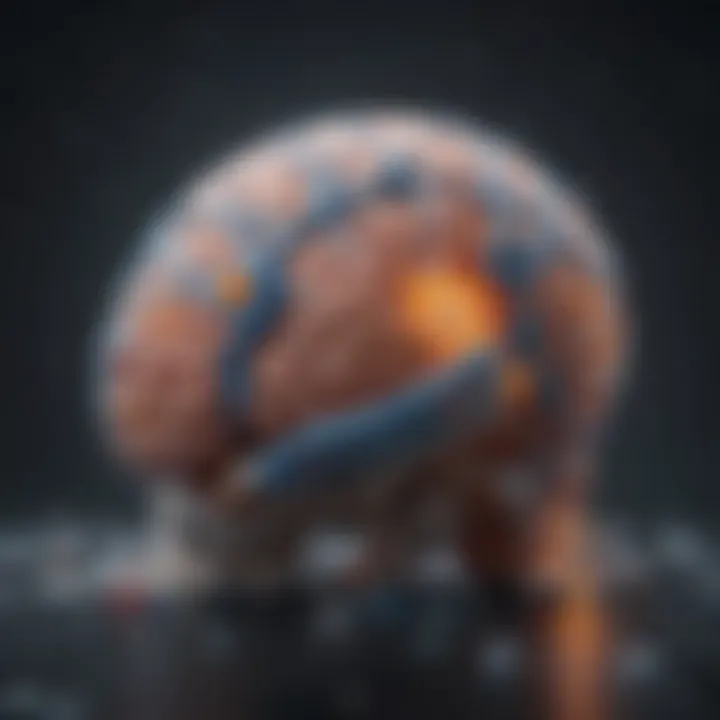Best Medication for Overactive Amygdala Treatment


Intro
The overactive amygdala produces noticeable emotional responses, leading to increasing anxiety levels. Understanding this brain region's role is crucial for developing effective treatments. This article examines various medication and therapeutic methods to manage these heightened reactions.
The amygdala is part of the limbic system. It helps process emotions like fear and pleasure. When functioning normally, it regulates feelings. However, if it becomes overactive, it can cause exaggerated emotional responses. This phenomenon is linked to disorders such as anxiety, PTSD, and depression.
The aim of this article is to delve into the medications that can help calm an overactive amygdala. It covers pharmacological treatments, including their mechanisms and potential side effects. Additionally, discussions on non-pharmacological tactics will also be presented. This comprehensive exploration will benefit students, researchers, educators, and professionals seeking effective strategies for managing emotional dysregulation.
Key Findings
Major Results
Several medications are found to target the overactive amygdala effectively. Selective serotonin reuptake inhibitors, such as Fluoxetine, and benzodiazepines like Diazepam, are commonly prescribed. These drugs aim to enhance emotional stability by balancing neurotransmitter activity in the brain.
Research indicates that cognitive-behavioral therapy (CBT) is also a viable approach. CBT helps individuals understand triggers and develop coping mechanisms for anxiety induced by amygdala hyperactivity. Other non-pharmacological methods, like mindfulness, can further support emotional regulation.
Conclusion: A combination of medication and therapy often yields the best outcomes for individuals affected by overactive amygdala.
Discussion of Findings
The interaction between medication and therapy plays a vital role. While certain medications can provide immediate relief, therapy focuses on long-term coping strategies. Observations show an increase in efficacy when these are combined, addressing both immediate symptoms and underlying issues.
It is essential to tailor treatment plans to the individual's specific needs. Factors such as the severity of symptoms and personal history should be considered. Collaboration with healthcare providers can ensure the chosen methods effectively address the unique aspects of an overactive amygdala.
Methodology
Research Design
This article reviews existing literature on medications and therapies for overactive amygdala. The analysis focuses on peer-reviewed articles and clinical studies to ensure reliability and validity of information.
Data Collection Methods
Data were gathered from multiple reputable sources, including recent studies published in psychological journals. Reports from healthcare institutions were also reviewed to provide a comprehensive overview. Online platforms like Wikipedia and Britannica offer pertinent background information, enriching the narrative with established facts.
In summary, understanding both pharmacological and non-pharmacological approaches provides a holistic view of managing an overactive amygdala. The diverse strategies cater to the multifaceted nature of emotional dysregulation, which enables individuals to regain control over their emotional well-being.
Understanding the Amygdala
Understanding the amygdala is crucial for grasping the complexities of anxiety disorders and emotional regulation. This almond-shaped cluster of nuclei is located deep within the temporal lobes of the brain. It plays a prominent role in processing emotions, particularly fear and pleasure. This article aims to elucidate the significance of the amygdala in emotional responses and memory formation while also discussing its overactivity and implications for mental health.
Anatomy of the Amygdala
The amygdala comprises several distinct regions, with each serving specific functions. Notably, the lateral amygdala is primarily involved in detecting sensory stimuli. In contrast, the central amygdala is vital for orchestrating emotional responses. The amygdala connects extensively with other brain areas, such as the hippocampus and the prefrontal cortex. These connections form a network that regulates both emotional states and cognitive processes. This anatomical arrangement underlines the amygdala's integral function in responding to environmental cues and emotional expressions.
Functions of the Amygdala
The amygdala is responsible for various functions essential to survival and adaptation. Its primary functions include:
- Emotion Processing: The amygdala evaluates emotional significance in experiences. This includes the detection of threats, which triggers fear responses.
- Memory Formation: Emotional experiences often influence memory retention. The amygdala enhances the encoding of memories associated with strong emotions.
- Behavior Regulation: The amygdala participates in the modulation of behaviors linked to emotions, including aggression and social responses.
These functions illustrate the amygdala's role as a central hub in balancing emotional and cognitive activities, which is critical for overall mental well-being.
Amygdala's Role in Emotion and Memory
The amygdala is pivotal in how emotions shape our memories. It interacts with the hippocampus, a region essential for forming new memories. When an experience elicits a strong emotional response, the amygdala signals the hippocampus to prioritize the storage of that memory. This dynamic ensures that past experiences influence future behaviors and decisions, often manifesting as learned responses to similar situations.
Additionally, overactivity of the amygdala can lead to heightened emotional responses, contributing to anxiety and stress disorders. Understanding this link is beneficial for developing effective interventions and treatments for individuals struggling with overactive amygdala-related conditions.
Hyperactivity of the Amygdala


Understanding hyperactivity of the amygdala is crucial in grasping the broader implications of emotional regulation and mental health. The amygdala, a small almond-shaped structure in the brain, plays a significant role in processing emotions such as fear and anxiety. When this area exhibits increased activity, it can lead to disproportionate emotional reactions, impacting one’s quality of life. This article seeks to explore the causes, symptoms, and clinical implications of this hyperactivity, and to what extent it influences treatment options.
Causes of Overactivity
The overactivity of the amygdala can be attributed to several factors. Chronic stress is one of the most significant contributors. Continued exposure to stress can lead to heightened sensitivity in this region, resulting in alarm signals being overly activated. Furthermore, traumatic experiences, especially during formative years, can shape the brain’s response, leading to persistent anxiety and a reactive amygdala. Other potential causes include genetic predisposition that affects brain chemistry, and certain neurological disorders which can cause alterations in amygdala function. Understanding these causes helps in identifying effective interventions.
Symptoms and Impacts
Individuals suffering from an overactive amygdala often report a range of symptoms. These can include excessive worry, irritability, and heightened emotional responses. In some cases, physical manifestations such as increased heart rate, sweating, or trembling may occur during anxiety-inducing situations. Importantly, the impacts of such symptoms extend beyond immediate emotional distress; they can lead to significant impairments in daily functioning, affecting personal relationships, job performance, and overall well-being. The knowledge of these symptoms brings attention to the seriousness of the condition, prompting the need for more effective management strategies.
Clinical Implications
The hyperactivity of the amygdala carries profound clinical implications. In many cases, it can lead to anxiety disorders such as generalized anxiety disorder, panic disorder, or specific phobias. Treatment modalities often have to be tailored to address not only the symptoms but also the underlying amygdala activity. Clinicians consider anxiolytics, antidepressants, and other medications that can help modulate the amygdala’s response. Moreover, understanding the relationship between amygdala hyperactivity and existing mental health conditions encourages a more integrated approach to treatment that encompasses both pharmacological and psychological interventions.
Diagnosing Overactive Amygdala
Understanding the methods for diagnosing an overactive amygdala is essential in addressing the anxiety that stems from its hyperactivity. Proper diagnosis allows healthcare professionals to devise tailored treatment plans. A comprehensive approach not only benefits the patient but also improves overall mental health outcomes.
When diagnosing overactivity in the amygdala, specific elements are crucial. These include clinical assessments and neuroimaging studies, which provide insights into brain function. Early diagnosis can facilitate intervention, reducing the long-term consequences of anxiety disorders.
Clinical Assessment Techniques
Clinical assessments serve as a foundational step in diagnosing overactive amygdala conditions. Typically, these assessments involve a range of interviews and standardized questionnaires. The approach allows clinicians to evaluate a patient’s symptoms and their intensity.
These assessments may use tools such as:
- Beck Anxiety Inventory: A widely accepted questionnaire that helps measure the severity of anxiety symptoms.
- Hamilton Anxiety Scale: The scale assesses the degree of anxiety based on clinical interviews.
- Patient Health Questionnaire: Often used to screen for depression, it can be relevant in understanding emotional states related to amygdala function.
During these evaluations, clinicians look for signs such as excessive fear responses, emotional dysregulation, and heightened vigilance. Emphasis is often placed on gathering an accurate history of the patient’s symptoms and their emotional experiences.
Neuroimaging Studies
Neuroimaging studies provide a more intricate layer for understanding amygdala overactivity. These studies capture brain activity and structure, offering valuable information that cannot be gleaned from interviews alone.
Common techniques include:
- Functional MRI (fMRI): This method measures brain activity by detecting changes associated with blood flow. It is essential for observing the amygdala's response to emotional stimuli.
- Positron Emission Tomography (PET): PET scans assess metabolic processes in the brain, showcasing how different areas, including the amygdala, are functioning in real time.
These imaging techniques can inform both diagnosis and treatment plans. By visualizing activity in the amygdala, healthcare providers can make informed decisions about interventions, including medication or therapeutic approaches.
Effective diagnosis is not just about identifying a problem; it’s about understanding it in context, enabling better treatment outcomes.
In summary, diagnosing an overactive amygdala involves a combination of clinical assessment techniques and neuroimaging studies. Each method plays a unique role in constructing a thorough understanding of symptoms. Adequate diagnosis is a critical step in managing an overactive amygdala and addressing associated anxiety.
Medications for Overactive Amygdala
The significance of selecting the right medication for an overactive amygdala cannot be overstated. These medications play a crucial role in alleviating symptoms associated with heightened emotional responses and anxiety disorders. The pharmacological treatments aim to restore balance in neurochemical pathways that the overactive amygdala disrupts. Hence, understanding the specific medications available, as well as their mechanisms, advantages, and disadvantages, is essential for individuals seeking effective management of their conditions.
Anxiolytics
Anxiolytics are a cornerstone in the treatment of overactive amygdala. They aim to reduce anxiety symptoms by modulating neurotransmitters in the brain. The effectiveness of anxiolytics stems from their ability to increase levels of gamma-aminobutyric acid (GABA), a neurotransmitter that inhibits excessive neuronal activity. Therefore, this class of medication is particularly beneficial for managing anxiety effectively. One unique feature is their rapid onset of action, which helps individuals experience relief in the short term.
Mechanism of Action
The mechanism of action for anxiolytics involves enhancing the effect of GABA at the GABA receptors. This leads to increased neuronal inhibition, effectively dampening the anxiety signals from the overactive amygdala. A key characteristic of this mechanism is the rapidity with which it provides relief to patients. However, dependence and withdrawal symptoms can arise if the medication is used for prolonged periods, which presents a drawback that mu$t be considered.
Commonly Prescribed Anxiolytics
Commonly prescribed anxiolytics include medications such as diazepam, lorazepam, and alprazolam. These drugs are popular choices due to their efficacy in addressing acute anxiety symptoms. Each of these medications has its characteristics—for example, diazepam has a longer half-life, making it suitable for extended relief. Despite their benefits, these medications come with risks, such as sedation and potential for abuse, thus necessitating careful management.


Side Effects and Risks
The side effects associated with anxiolytics can range from drowsiness to cognitive impairment. Additionally, risks such as dependency and withdrawal symptoms are significant considerations. A common feature among all anxiolytics is the potential for increased tolerance, leading patients to require higher doses for the same effect. These factors underscore the need for close monitoring by healthcare professionals to mitigate adverse effects while maximizing treatment efficacy.
Antidepressants
Antidepressants serve as another essential tool in managing an overactive amygdala. They primarily address underlying mood disorders that often accompany heightened anxiety. Selective serotonin reuptake inhibitors (SSRIs) and norepinephrine-dopamine reuptake inhibitors (NDRIs) are two classes frequently explored. These medications can help normalize emotional responses and improve overall mood.
Selective Serotonin Reuptake Inhibitors
SSRIs, including fluoxetine and sertraline, work by blocking the reabsorption of serotonin in the brain. This increase in serotonin levels can significantly stabilize mood and reduce anxiety. Their popularity arises from their efficacy and comparatively favorable side effect profile than older antidepressants. However, a potential delay in achieving the full therapeutic effect is a notable disadvantage.
Norepinephrine-Dopamine Reuptake Inhibitors
NDRIs, such as bupropion, also play a role in managing overactive amygdala conditions. They enhance norepinephrine and dopamine levels, positively affecting energy and mood. A distinctive feature of NDRIs is their lower propensity to cause sexual side effects. Yet, they can induce insomnia and other stimulatory effects, which complicates their use in some patients.
Balance Between Efficacy and Side Effects
Striking a balance between efficacy and side effects in antidepressant therapy is critical. Patients often report different responses to medications, prompting providers to tailor treatments according to individual needs. This characteristic of personalized medicine, while beneficial in achieving improved outcomes, requires time and patience to determine the most suitable therapy for each individual.
Beta Blockers
Beta blockers are another medication class that can be beneficial for individuals with an overactive amygdala. While traditionally used for cardiovascular conditions, these medications help manage physical symptoms of anxiety, such as elevated heart rate and palpitations. Understanding their applications is vital for comprehensive anxiety management.
Applications in Anxiety Management
Beta blockers, like propranolol, can reduce the physiological symptoms of anxiety without directly affecting psychological symptoms. This unique characteristic makes them particularly useful in situations of performance anxiety or panic attacks. Their efficacy in these specific scenarios highlights their role in broader anxiety management.
Effectiveness in Reducing Physical Symptoms
These medications are effective in alleviating symptoms such as tremors and rapid heartbeat that often accompany anxiety. This physical symptom reduction creates an environment where individuals feel more at ease, facilitating more effective engagement in therapy or daily activities. However, it is important to note that they do not address the cognitive aspects of anxiety disorders.
Considerations for Use
When considering beta blockers, healthcare providers should evaluate any potential interactions with other medications. Moreover, the varying individual responses necessitate a careful approach to dosing and monitoring. These considerations ensure that beta blockers can be used safely and effectively in individuals experiencing anxiety related to overactive amygdala.
Antipsychotics
Atypical antipsychotics also have a role in treating anxiety disorders related to an overactive amygdala. These medications can be utilized particularly when other treatments have proven ineffective or when patients experience significant mood dysregulation. Understanding this application can broaden therapeutic options for clinicians and individuals alike.
Role of Atypical Antipsychotics
Atypical antipsychotics, such as quetiapine and aripiprazole, have unique actions that can stabilize mood and reduce anxiety. Their function within the serotonergic and dopaminergic systems helps address the underlying neurochemical imbalance in individuals. This broad neurochemical impact is a key reason they have gained popularity in treating complex cases of anxiety and mood disorders.
Commonly Used Antipsychotic Medications
Medications like olanzapine and risperidone are among the commonly used atypical antipsychotics for managing anxiety. Their varied mechanism of action can provide different therapeutic benefits. While effective, these medications require careful monitoring for metabolic side effects, such as weight gain and altered glucose metabolism, which can pose significant risks.
Monitoring for Side Effects
Monitoring for side effects is crucial when prescribing antipsychotics due to their potential adverse effects. Regular assessments can help catch any negative impacts early, allowing for timely adjustment of treatment plans. This oversight is vital for maximizing the benefits while minimizing risks associated with this class of medication.
Non-Pharmacological Treatments
Non-pharmacological treatments play a vital role in managing the impact of an overactive amygdala. While medications can alleviate symptoms, these approaches focus on enhancing emotional regulation and reducing anxiety through various strategies. They can be crucial complements to pharmacotherapy, offering holistic options for individuals. Non-pharmacological methods often encourage the development of coping skills that foster resilience against stressors.
Cognitive Behavioral Therapy
Cognitive Behavioral Therapy (CBT) is widely recognized as an effective approach for addressing overactivity in the amygdala. This therapy centers on the interconnection between thoughts, emotions, and behaviors. By identifying and challenging negative thought patterns, individuals learn to modify their responses to anxiety-provoking stimuli. CBT equips individuals with practical insights and coping strategies, which can empower them to manage their emotional responses more effectively. It also involves exposure techniques that help desensitize individuals to triggers, ultimately leading to decreased amygdala reactivity over time.


Mindfulness and Meditation
Mindfulness and meditation are significant tools for calming an overactive amygdala. These practices cultivate a state of awareness and presence, enabling individuals to observe their thoughts without immediate judgment. Mindfulness can effectively reduce stress, enhance emotional regulation, and improve overall well-being. Regular practice may lower activation in the amygdala and foster a sense of calm. Using techniques such as deep breathing and body scanning, individuals can create an internal environment conducive to relaxation and peace. This method draws attention away from anxiety-producing thoughts and redirects focus to the present moment.
Lifestyle Modifications
Lifestyle modifications can substantially impact the management of amygdala hyperactivity. These changes improve overall mental health and resilience against anxiety.
Exercise and Physical Activity
Exercise and physical activity contribute positively to emotional regulation through the release of endorphins. Engaging in regular exercise not only improves mood but also reduces stress levels significantly. Physical activity is a beneficial choice in this context because it can lower amygdala reactivity and enhance overall brain function. Unique features of exercise include its accessibility and proven efficacy. While finding time to exercise can be challenging for some, the advantages of consistent physical activity far outweigh these difficulties.
Dietary Considerations
Diet plays an essential role in managing anxiety and overall mental health. Foods rich in omega-3 fatty acids, such as salmon and walnuts, support brain function and can potentially aid in regulating a hyperactive amygdala. Furthermore, a balanced diet fosters steady energy levels and optimal cognitive performance. The unique feature of dietary considerations is the potential long-term impact on mental health via nutritional choices. However, individuals should be aware that dietary changes might not provide instant results and thus necessitate patience and commitment.
Sleep Hygiene
Sleep hygiene is crucial for emotional health. Poor sleep can exacerbate symptoms related to an overactive amygdala. Establishing a bedtime routine can create an environment conducive to restful slumber. Consistent sleep schedules and relaxation techniques before bed can clear the mind, reducing anxiety. The beneficial influence of sleep hygiene stems from its ability to improve mood and cognitive function. Ensuring quality sleep is a straightforward yet vital choice in managing anxiety. Although implementing these strategies may require initial effort and planning, the end benefits of improved well-being justify the commitment.
Current Research and Trends
In understanding and treating an overactive amygdala, current research and trends play a critical role. The ongoing discoveries in neuroscience and psychology shed light on the mechanisms underlying amygdala function and its implications for mental health. These research endeavors help refine existing treatment methods and inspire innovative approaches, which can be pivotal in managing the emotional dysregulation associated with amygdala hyperactivity.
Recent studies delve into the intricacies of the amygdala’s responses to various stimuli. They highlight how the amygdala interacts with other brain regions and how this interaction affects emotional responses. This knowledge is crucial for developing targeted treatments that can stabilize the emotional state of individuals struggling with anxiety and related disorders.
Additionally, the trend toward personalized medicine is becoming increasingly important in the field. By tailoring treatments based on an individual's unique biological and psychological profile, practitioners can enhance the efficacy of interventions. This trend offers the potential for improved outcomes, reducing the trial-and-error approach that can often characterize treatment for mood disorders.
"Advancements in neuroscience could lead to a future where treatments for anxiety are more effective and precise, minimizing side effects while maximizing benefits."
Recent Studies on Amygdala Function
Recent studies have greatly contributed to our understanding of the amygdala and its dysfunctions. Research utilizing neuroimaging techniques, such as functional MRI, reveals how individuals with an overactive amygdala respond differently to emotional stimuli compared to those with normal function. Researchers found heightened activity in the amygdala during exposure to fearful or threatening faces, indicating a strong link between amygdala hyperactivity and anxiety-related behaviors.
Moreover, investigations into genetic factors that influence amygdala function are emerging. Certain gene variants have been associated with anxiety traits, suggesting that these factors may contribute to the amygdala's overactivity in some individuals. Understanding these connections allows for the development of targeted genetic-based interventions, potentially improving treatment strategies.
Finally, a growing body of literature is examining how environmental factors, including stress and trauma, impact amygdala function. This emphasizes the importance of considering an individual's life experiences when addressing emotional disorders. Health professionals can use this information to provide more holistic treatment options.
Emerging Treatment Modalities
Emerging treatment modalities reflect the need for innovative strategies to address the complexities surrounding overactive amygdala. One area of focus is neuromodulation techniques, such as Transcranial Magnetic Stimulation (TMS) and Deep Brain Stimulation (DBS). These methods aim to alter neural activity and provide relief from symptoms of anxiety and depression.
Furthermore, there's an increased interest in developing pharmacological agents that specifically target the neurochemical pathways involving the amygdala. Drugs that influence neurotransmitters like serotonin, dopamine, and norepinephrine are undergoing research to ascertain their effectiveness in modulating amygdala responses.
Another trend is integrating technology in therapeutic processes. Mobile apps and digital platforms are being explored for their potential to deliver cognitive behavioral therapy and mindfulness training. These tools can provide accessible, on-demand treatment options for individuals with anxiety, making it easier for them to manage symptoms in real-time.
Lastly, collaboration between researchers and clinicians is vital for translating findings into practice. This synergy encourages ongoing experimentation and adaptation of therapeutic techniques, ultimately fostering a more effective approach to treating conditions associated with an overactive amygdala.
The End
The conclusion serves as a pivotal element in understanding the complexities associated with an overactive amygdala and the available treatments. This section is not merely a summary; it distills essential insights drawn from the entire discourse surrounding pharmacological and non-pharmacological interventions. As the discussion highlights, amygdala hyperactivity is intricately linked to anxiety and emotional disturbances, affecting individuals’ quality of life significantly.
Summary of Key Points
In this article, we have explored several aspects related to the overactive amygdala. Key points include:
- Anatomy and Function: Understanding the amygdala's role in emotional regulation laid the groundwork for recognizing why its overactivity may lead to heightened anxiety and fear responses.
- Medication Options: We examined various pharmacological treatments such as anxiolytics, antidepressants, beta blockers, and antipsychotics. Each category presents unique mechanisms, efficacy, and potential side effects, providing a spectrum of choices for clinicians and patients alike.
- Non-Pharmacological Approaches: Cognitive-behavioral therapy, mindfulness techniques, and lifestyle changes are indispensable complements to medication, offering broader avenues for managing symptoms associated with amygdala hyperactivity.
- Current Trends and Research: Ongoing studies are enhancing the understanding of the amygdala's function and its implications, leading to the exploration of innovative treatment modalities.
Future Directions in Treatment
As the field surrounding the treatment of an overactive amygdala evolves, several future directions warrant attention:
- Personalized Medicine: Understanding individual differences in response to medication may pave the way for tailored treatments that improve efficacy while minimizing side effects.
- Integration of Neuroimaging: Advanced imaging techniques can provide deeper insights into how different treatments impact amygdala activity, guiding the choice of interventions based on individual neurophysiology.
- Research on Emerging Therapies: Continuous investigation into new pharmacological agents, including those targeting specific neurotransmitter systems, could yield alternatives with fewer side effects.
- Holistic Approaches: As an awareness grows regarding the importance of mental health, combining medication with lifestyle modifications and therapeutic practices might become more standard in treatment protocols.
Reflecting on these aspects is crucial for advancing our understanding and management of amygdala-related anxiety disorders. As the psychological landscape shifts, ongoing research and clinical practice will play a vital role in shaping future therapeutic strategies.



